|
|
|
|
|
OCAU Server Upgrade |
|
Join the community - in the OCAU Forums!
|
Reconsidering Thor, Chips in Detail
The next problem was mounting the motherboard. Despite being an Extended ATX motherboard in an Extended ATX case, there was one permanent motherboard standoff in the case which didn't align with a hole in the motherboard. Left in place, it would short pins on the bottom of the IDE cable connectors. This is unacceptable, so out came the Dremel and off came the motherboard standoff. I used a plastic spacer for that corner of the motherboard.
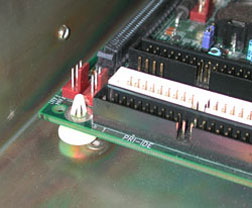 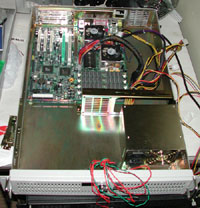
While I had the dremel out, I cut away the fan grille on the internal fan rail. I assume this grille is to stop cables from being sucked into the fan and possibly jamming it, but the grille is so restrictive that the fan produced this high-pitched tearing scream that I simply couldn't handle being in the same room as, never mind what it was doing to airflow. A normal silver-wire fan grille will protect the fan from cables and fingers but have almost no restriction to airflow. A grille on the intake side of the rear case exhaust fan is a good idea too, to stop a cable jamming it.
While on the subject of Dremeling, I was extremely paranoid about metal shavings shorting components. I pulled the entire case apart and removed all wiring, switches, faceplates etc and left them aside. The stripped case came with me to the shed where it was modified, then thoroughly swept with a dry paintbrush and vacuum cleaner to make sure no metal filings were left lying around to work their way into PCI slots or other places were random conductivity is bad. I even changed my clothes and throughly washed my hands and arms to make sure I wasn't dragging particles around.
The next problem was to do with the RAID controller. Adaptec thoughtfully provide a half-height PCI backplate and the PCB is also short, so that the controller can be used in a 2RU case. The problem is, this particular 2RU case has the PCI slot covers horizontally, and provides a PCI riser card to allow you to insert your PCI devices at 90 degrees to the motherboard. The only PCI card we're using in this case is the Adaptec RAID controller, but it's a 64-bit card and the riser provided with the case is 32-bit! I considered a hugely bodgy Dremel attack on that corner of the case to allow the card to be installed vertically, but decided that was too dodgy even for me. A quick documentation hunt revealed that the Adaptec WOULD work in a 32-bit slot, and realistically with only two drives we're probably not exceeding a 32-bit slot's bandwidth, but for short bursts of data it would be nicer to have. Remember that the Adaptec has 64MB of cache onboard and a dedicated processor - it's best if the main system CPUs can throw data at the RAID controller then forget about it, so the more bandwidth the better. But with only a 32-bit riser and with time being of the essence we'd have to cope.
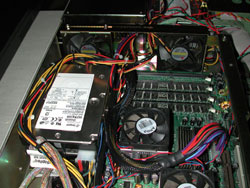 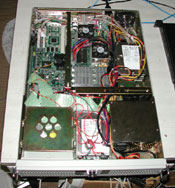
So, pie was now built, with the RAID array between two fans for cooling, the PSU successfully butchered and installed, motherboard mounted correctly and the other two drives - the 10k-rpm U320 Seagate for system files and the Western Digital 120GB IDE drive for backups - installed in the front drive bay with a fan sucking air past them. The RAID card was installed, if only in a 32-bit riser, and testing could get underway.
Reconsidering Thor and Sauce
About this time I started to think about Thor's suitability for re-use. I mean, it didn't really seem all that good an idea to rebuild it into a 2RU case and send it back out again. For a start, the hard drive would have to be replaced, after being thrashed mercilessly for two years solid - and it was secondhand when I got it. Two P3-1000EB CPU's aren't exactly cutting-edge nowadays and although the motherboard had performed flawlessly it was never server-class, being an ABIT VP6 using the Apollo Pro 133 chipset, infamous for low memory bandwidth. Realistically, even a single-CPU Pentium 4 system with DDR memory would outperform it hugely, especially if we could arrange a P4 with Hyper-Threading. I happened to wander into our For Sale forum, something I rarely do - it may even have been in response to a Reported Post email - and noticed a ready-to-go 1RU P4 system for sale for what seemed a bargain price. I snapped it up and in a few days OCAU's new webserver, chips was in my hot little hands. This marked the impending end of Thor's reign, and the "Sauce" idea never got off the ground. Thor served us very well but will be sold once fully retired. In fact I still have it - it was used for a test upgrade of our forums to VBulletin 3 recently.
Chips in Detail
1RU cases seem really bizarre the first time you see one. They're hugely long, because everything is arranged front-to-back along the case. Consider that the tallest thing you can fit in them is a normal CDROM drive and you realise how serious the height issue is.
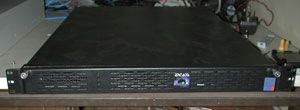
Fortunately this machine was ready to go, with a Tyan Trinity i845E motherboard, P4 CPU with 1RU-compatible cooler, WD1200JB hard drive and two 512MB sticks of Kingmax DDR400 memory. This saved me the trouble of having to source components to squeeze into the case, allowing me to simply customise what we needed.
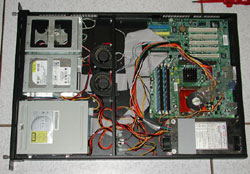
As it turned out, the only real change I made was to install a CDROM drive, rearrange some of the cooling and replace the CPU. It arrived with a 2.4GHz P4 without Hyper-Threading. The motherboard supports 533MHz FSB maximum and the only HT CPU at that speed is the 3.06GHz. Still, for a smidge over $300 AUD at the time, that provides a lot more grunt than we currently need and hopefully a fair bit of future-proofing. Remember that virtually all this machine has to do is run the Apache webserver. 1GB is plenty of memory and the hard drive, although not SCSI, should cope fine with the load of Apache logging. In terms of cooling, this case is quite well set up. The seller apologised for the dodgy CPU ducting set up - it seems to be made from a single-stick RAM package - but it actually works really well. The blower draws air through the all-copper heatsink and ejects it via this duct out the back of the case. I left it intact and it copes fine even with the 3.06GHz CPU, running folding@home on both virtual (Hyper-Threading) CPUs, which is a lot more CPU load than it will experience in production use.
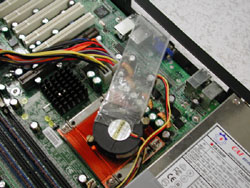
|
|
Advertisement:
All original content copyright James Rolfe.
All rights reserved. No reproduction allowed without written permission.
Interested in advertising on OCAU? Contact us for info.
|

|


